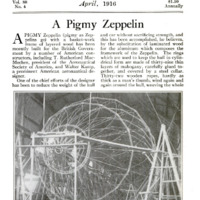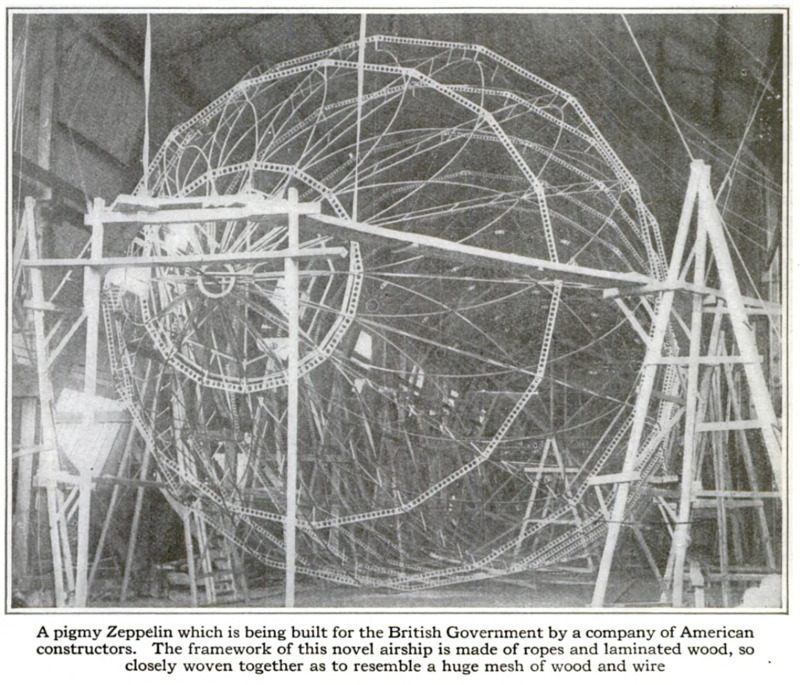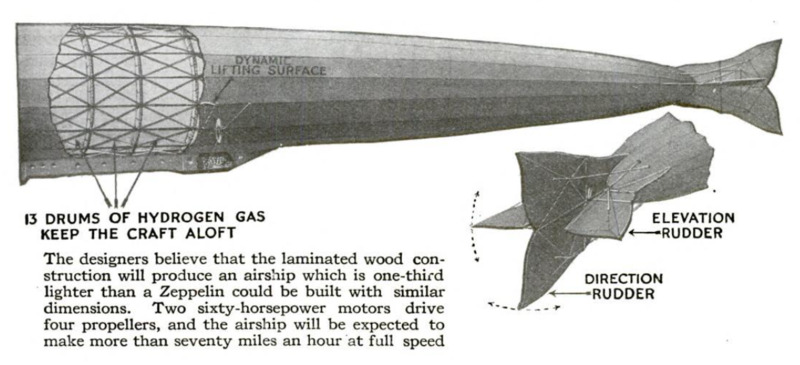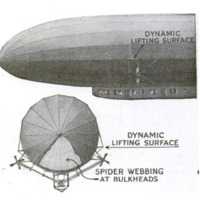-
Title (Dublin Core)
-
A Pigmy Zeppelin
-
Article Title and/or Image Caption (Dublin Core)
-
A Pigmy Zeppelin
-
extracted text (Extract Text)
-
A PIGMY Zeppelin (pigmy as Zep-
pelins go) with a basket-work
frame of layered wood has been
recently built for the British Govern-
ment by a number of American con-
structors, including T. Rutherford Mac-
Mechen, president of the Aeronautical
Society of America, and Walter Kamp,
a prominent American aeronautical de-
signer.
One of the chief efforts of the designer
has been to reduce the weight of the hull
and car without sacrificing strength, and
this has been accomplished, he believes,
by the substitution of laminated wood
for the aluminum which composes the
framework of the Zeppelin. The rings
which are used to keep the hull in cylin-
drical form are made of thirty-nine thin
layers of mahogany, carefully glued to-
gether, and covered by a steel collar.
Thirty-two wooden ropes, hardly as
thick as a man’s thumb, wind again and
again around the hull, weaving the whole
into a great mesh of basket-work. = Six-
teen slender members form the longi-
tudinals, running from how to stern, and
intersecting the spirals of wooden rope
where they cross each other. The func-
tion of the spirals and longitudinals
acting together is to distribute the gas
lift and strains evenly to all points of the
hull.
There are, in reality, two hulls, the
inner enclosing thirteen balloonets or
gas bags and the outer supporting a
waterproof and airtight envelope or
skin. Twenty-nine ribs, or transverse
girders, encircle the inner hull, and a
spider web of wire cables stiffens the
alternate ribs and forms the bulkheads
between the balloonets.
Two cight-cylinder, sixty-horsepower
motors have been installed, and by
means of cable drives transmit the power
to four propellers mounted high above
the car, two being placed on each side of
the slender torpedo-like hull.
In hot weather, or when the airship
passes through a heated stratum of air,
the gas expands, exerting more lifting
power, and causing the airship to rise.
To control this tendency, the gas has to
be artificially cooled, or it will be neces-
sary to release some of the valuable
hydrogen to allow the ship to retake its
proper altitude. On the contrary, if a
sudden wave of cold air strikes the gas
bag, the gas immediately contracts, and
part of its lifting power is lost. If there
is no means for heating the gas and ex-
panding it, ballast will have to be
dropped from the car, thus compensating
the decreased lifting power of the gas
by a lighter weight which it has to
carry.
The control of the lifting power of the
gas in the MacMechen dirigible is in
the heating and cooling process. To
keep the hydrogen from cooling and
losing its lifting power, hot vapor from
the engine is blown into the foot-wide
space between the balloonets and the
outer skin of airtight cloth. To cool and
condense the gas for descent, or to pre-
vent its expansion to an extent that
causes an undue inflation of the gas bags,
cold air is introduced into the same space
by means of a luminum disks with re-
volving shutters at the bow and stern.
It is claimed that by this method of
will make about seventy miles an hour,
or about ten miles an hour faster than
the speed of a Zeppelin.
The Porurar Scinxci: MONTHLY be-
lieves that this airship will prove disap-
pointing to its builders and to the
British Government. Previous experi-
ments with wooden frames in dirigibles
have proved costly failures. The Zep-
pelin’s first rival, the Schiitte-Lanz
dirigible, was built with wooden frame-
work, and proved much heavier than a
Zeppelin of the same dimensions. Lami-
nated wood was used in the experiment
and this was found faulty and discarded.
The Zeppelin of to-day is the product of
practical experience, as is the second,
and successful, Schiltte-Lanz, which
discarded the weblike wooden frame for
the lighter metal ribs and strakes of the
Zeppelin. Such a solid frame as that of
the pigmy airship would not do for a
larger dirigible, for it loses the greater
lightness for the same strength of a
small structure. In a small dirigible
resistance against propulsion is so much
greater than the \ift available for engine
power in the large craft, that it com- |
pletely discounts the small craft's struc-
tural advantages. Any improvements in
lightness and strength will, therefore,
never make this pigmy Zeppelin a
superior in speed to its larger and more
powerful rival.
The whole idea of a small and speedy
“aerial destroyer” is mistaken, since in a
dirigible everything has to take second
place to speed; otherwise Zeppelin,
which cannot seek safety in landing,
would be at the mercy of the wind.
The rope drive to the propellers has
been proved greatly inferior to bevel
gearing, chains and belts. The cable
drive was tested on the first Gross-
Basenach, but was quickly discarded.
The most meritorious feature of the
design of the pigmy Zeppelin is in the
alternate heating and cooling of the gases
by hot vapor from the engine and cool
air sucked in by blowers. This certainly
should prove of valuable assistance to
the dynamic lift-control without en-
tailing much additional weight.
In conclusion, it seems that the idea
of a wooden frame has been tried, ap-
proximately in its present form, and
found lacking. The rope drive has been
succeeded by more efficient means of
power transmission, and the entire trend
of dirigible construction has been to in-
crease the lifting power, and consequent-
ly the size, in order to achieve greater
power and speed. Whether the Zeppelin
has been a success or not is a mooted
point, but the Zeppelin has been the
only 'dirigible that has accomplished
anything of note in this war, and the
smaller dirigibles have been permarently
relegated to their hangars.
A Barbed-Wire-Proof Fabric
ONE of the most trying tasks incident
to trench fighting has been consid-
crably lightened by the appearance in
the British trenches of gloves made of a
fabric which is said to be impervious to
barbed-wire points. The fabric is made
up into mittens, with the first finger and
thumb separate. The fabric is water-
proof, and in addition the gloves are
insulated for gripping electrically-
charged wires.
The same material is applied to the
manufacture of ~sleeping-bags, which,
when opened, may be thrown over a
barbed-wire entanglement to allow a
soldier to climb over the sharp points
without injury. When made up into
vests or tunics, the fabric is strong
enough to turn shrapnel splinters, or
even a bullet when it has lost part of its
momentum. The interlining is anti-
septicized, so that if a bullet goes
through, it takes into the wound enough
antiseptic wool to prevent poisoning.
The materials used in the manufacture
of this remarkable fabric have been
sedulously kept secret this far.
-
Language (Dublin Core)
-
eng
-
Date Issued (Dublin Core)
-
1916-04
-
pages (Bibliographic Ontology)
-
483-485
-
Rights (Dublin Core)
-
Public Domain (Google digitized)
-
Archived by (Dublin Core)
-
Filippo Valle
-
Alberto Bordignon (Supervisor)
 Popular Science Monthly, v. 88, n. 4, 1916
Popular Science Monthly, v. 88, n. 4, 1916







